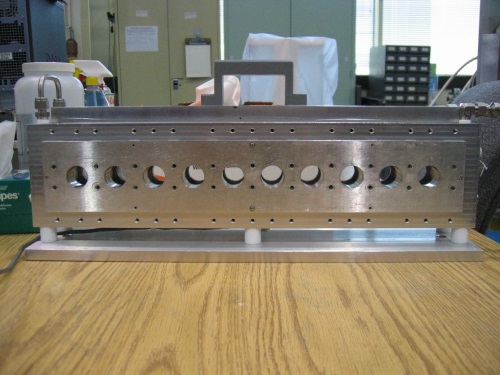
Approximately 50% of all SANS instrument users use the 10 position (10CB) and 6-position (6CB) cooling blocks. The 6CB is exclusive to the USANS instrument. The sample changers are heated and cooled using a thermal fluid passing through the outer walls of the block. Typically, the circulating bath temperature is used as the control point and the block temperature is recorded in a log file.
Each temperature block has an RTD installed to monitor the block temperature. On NG7 SANS, a 2nd RTD is installed and is used as the control temperature. The two RTDs in the block have been calibrated to be within 0.2 °C of one another at the equilibration temperature.
Temperatures from 5°C to 90°C can be achieved with an accuracy of 0.5°C when used with a NESLAB© circulating bath filled with a 50%/50% mixture of water and ethylene glycol. Temperatures from -25°C to 130°C can be achieved with an accuracy of 0.2°C when used with a Julabo© or Huber© circulating bath filled with silicon oil. The silicon oil configuration is currently available on NG7 SANS and BT5 USANS, and will be coming soon to NGB30m SANS.
To ensure optimal temperature stability, quartz windows are installed before the sample and silicon or quartz windows are after the sample. Quartz is optically transparent and transmits a laser beam used for the rough alignment of the sample block. More precise alignment is done using a neutron camera behind the block along with the double exposure method (taking two pictures, one with the sample aperture in the beam and another without the sample aperture).
NG3 SANS 10-Position Cooling Block Temperature Calibration Curve
NG7 SANS 10-Position Cooling Block Temperature Calibration Curve
SANS Home |
SANS Instruments |
Sample Enviroments |
SANS Publications |
Instrument Schedules
SANS Staff |
Data Reduction and Analysis |
Tutorials |
Info For Users |
SANS Calculations